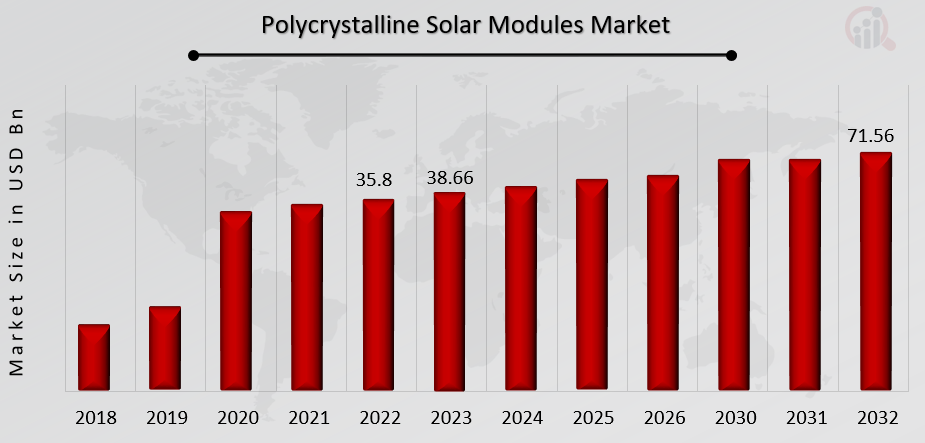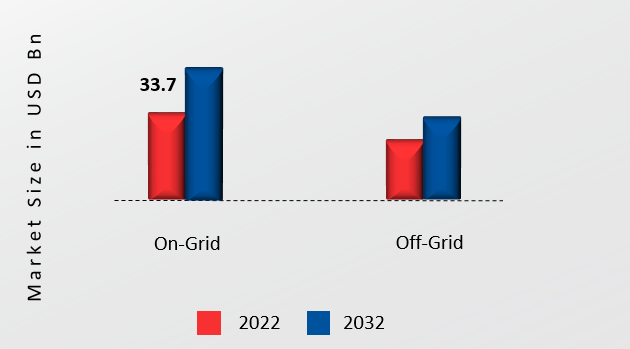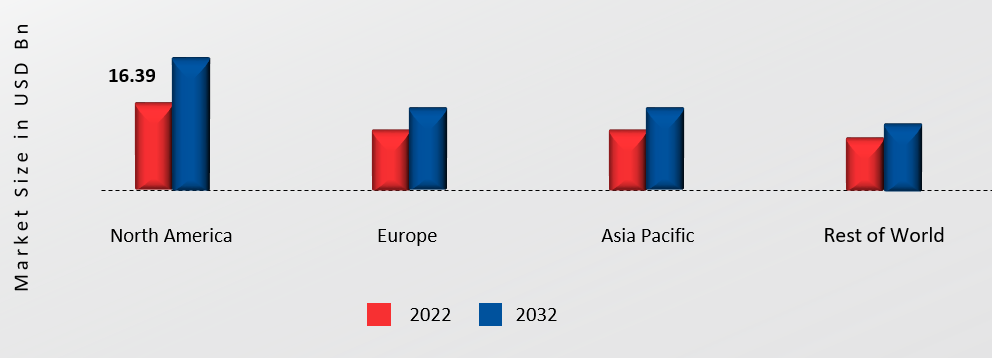Global Polycrystalline Solar Modules Market Overview:
Polycrystalline Solar Modules Market Size was valued at USD 35.8 Billion in 2022. The Polycrystalline Solar Modules market industry is projected to grow from USD 38.66 Billion in 2023 to USD 71.56 Billion by 2032, exhibiting a compound annual growth rate (CAGR) of 8.00% during the forecast period (2023 - 2032). Increasing demand for renewable energy and technological advancements are the key market drivers enhancing the market growth.

Source: Secondary Research, Primary Research, MRFR Database and Analyst Review
Polycrystalline Solar Modules Market Trends
-
Rising smart solar technologies are driving market growth
Polycrystalline solar modules may be monitored in real time due to smart solar technologies. Utilizing machine learning algorithms and data analytics, the gathered information may be used to forecast maintenance requirements, detect performance problems, and maximize energy production. This lowers downtime and increases overall efficiency. The integration of IoT connectivity facilitates smooth communication among various solar installation components, such as energy storage systems, inverters, and polycrystalline modules. This connectivity makes the ability to remotely monitor, operate, and manage the complete solar system possible, which enhances operational effectiveness.
The energy yield of polycrystalline solar modules is greatly increased using bifacial technology, which collects sunlight from both the front and reflective surfaces, like the ground or surrounding buildings. Higher total energy production results from this, increasing the allure of polycrystalline modules with bifacial technology for solar projects. High albedo settings with lots of sunlight reflection are ideal for bifacial solar modules. Therefore, they can be used in various settings, including urban settings where light is reflected off surfaces and buildings, icy places, and areas near bodies of water.
Excess energy generated during intense sunlight can be stored in energy storage devices integrated with polycrystalline solar modules. By utilizing the stored energy at times of low sunshine or high demand, the grid will remain stable, and the power supply will be more dependable and steady. Solar power production is naturally erratic because of things like the weather and the length of the day. Storage stores excess energy during high production and releases it during low production to provide a more consistent energy output.
Additionally, China stated in 2021 that it intended to increase the total amount of non-pumped hydro energy storage installed to approximately 30 GW by 2025 and 100 GW by 2030. These announcements, along with the recent implementation of time-of-use power tariffs that increase the difference between peak and off-peak electricity prices, contribute to the battery storage activity surge.
All Chinese residences and commercial buildings built before 2023 will have solar photovoltaic systems mounted on their roofs. A government regulation will require the installation of solar photovoltaic systems on a specific number of buildings. Solar PV roof-top systems are required for the following buildings: all government buildings (no less than 50%), public buildings (40%), residential buildings (30%), and rural buildings (20%) throughout roughly 676 counties. Thus driving the Polycrystalline Solar Modules market revenue.
Polycrystalline Solar Modules Market Segment Insights:
Polycrystalline Solar Modules Connectivity Insights
The Polycrystalline Solar Modules market segmentation is based on connectivity, including on-grid and off-grid. The on-grid segment dominated the market. Net metering programs are frequently implemented in conjunction with on-grid connectivity. Owners of solar systems that generate extra electricity and feed it back into the grid can get credits for it due to net metering. When solar generation is low, these credits can be utilized to balance the electricity taken from the grid.
During the forecast period, the off-grid segment is expected to be the fastest-growing polycrystalline solar modules market segment. Off-grid polycrystalline solar systems use sunshine to produce power independently, independent of the central grid. They are, therefore, appropriate for distant or remote areas where grid connectivity is impossible.
Figure 1: Polycrystalline Solar Modules Market, by Connectivity, 2022 & 2032 (USD Billion)

Source: Secondary Research, Primary Research, MRFR Database and Analyst Review
Polycrystalline Solar Modules Mounting Insights
The Polycrystalline Solar Modules market segmentation based on mounting includes ground-mounted and roof-top. The ground-mounted category has the largest market share. Ground-mounted mounting works well in wide spaces with lots of space, including fields, meadows, or vacant sections of industrial sites. This arrangement enables the effective use of open spaces to optimize solar energy capture.
Throughout the forecast period, the polycrystalline solar modules market’s roof top segment is anticipated to grow at the quickest rate. Polycrystalline solar module roof-top installations are common for residential buildings. Homeowners can use solar energy without taking up a large amount of garden space, which promotes energy independence and reduces energy costs.
Polycrystalline Solar Modules End-Use Insights
Based on end-use, the Polycrystalline Solar Modules market segmentation includes residential, commercial, and utility. The utility category leads the market. Renewable portfolio requirements have been implemented in several areas, mandating that utilities produce a specific portion of their electricity from renewable sources. Utilizing polycrystalline solar modules, utility-scale solar projects help to achieve these requirements.
During the projection period, the polycrystalline solar modules market’s residential segment is anticipated to grow fastest. Batteries and other energy storage technologies are used in certain residential solar setups. This enables homes to store extra electricity the sun produces during low solar production or power disruptions.
Polycrystalline Solar Modules Regional Insights
By region, the study provides market insights into North America, Europe, Asia-Pacific, and the Rest of the World. The North American polycrystalline solar modules market area will dominate this market. The use of renewable energy has been encouraged by the implementation of favorable government policies and financial incentives by North American nations, especially the United States and Canada. Installation of solar power systems, especially polycrystalline solar modules, is encouraged by tax credits, rebates, and incentives offered by the federal and state governments.
Further, the major countries studied in the market report are the US, Canada, Germany, France, the UK, Italy, Spain, China, Japan, India, Australia, South Korea, and Brazil.
Figure 2: Polycrystalline Solar Modules Market Share By Region 2022 (Usd Billion)

Source: Secondary Research, Primary Research, MRFR Database and Analyst Review
Europe's Polycrystalline Solar Modules market accounts for the second-largest market share because European countries have committed to tackling climate change by setting high goals for renewable energy. Implementing solar technologies, such as polycrystalline solar modules, is necessary to attain these objectives and facilitate the shift towards a more sustainable energy environment. Further, the German Polycrystalline Solar Modules market held the largest market share, and the UK Polycrystalline Solar Modules market was the fastest-growing market in the European region.
The Asia-Pacific Polycrystalline Solar Modules Market is expected to grow fastest from 2023 to 2032. This is because urbanization and population growth have increased the demand for power in the Asia Pacific. Due to their low cost, polycrystalline solar modules are an excellent choice for supplying the region's rural and urban areas with electricity. Moreover, China’s Polycrystalline Solar Modules market held the largest market share, and the Indian Polycrystalline Solar Modules market was the fastest-growing market in the Asia-Pacific region.
Polycrystalline Solar Modules Key Market Players & Competitive Insights
The Polycrystalline Solar Modules market continues to grow due to major players investing heavily in R&D to expand their product offerings. Market participants also participate in several strategic initiatives to strengthen their footprint. The industry has seen significant developments with the launch of new products, agreements, mergers and acquisitions, higher investment, and collaboration with other companies. For the Polycrystalline Solar Modules industry to expand and prosper in a market that is becoming more competitive and dynamic, it must offer reasonably priced products.
Manufacturers in the Polycrystalline Solar Modules industry use this strategy primarily to service customers and grow their market share: they manufacture locally to reduce operating costs. The polycrystalline solar module industry has benefited medicine tremendously in recent years. Major players in the Polycrystalline Solar Modules market, including GCL System Integration Technology Co. Ltd., Rec Solar, First Solar, Trina Solar, Canadian Solar, Hanwha Q Cells, JA Solar, Solaria Corporation, Jinko Solar, China Sunergy (Nanjing) Co., Ltd, and others, are attempting to increase market demand by investing in research and development operations.
Solar energy solutions are offered by (Canadian Solar Inc.). Solar ingots, wafers, modules, cells, and other solar power products are designed, developed, and produced by the company. Many of its solar modules are used in solar power generating systems for homes, businesses, and industries. Its specialist solar goods include customized solar modules that clients incorporate into their products, including mobile solar home systems. Distributors, project developers, system integrators, installers, and EPC businesses are all served by Canadian Solar. Canadian Solar Inc. announced in March 2022 that it has started producing new 54-cell type modules in large quantities. These modules, which have 182 mm cells, are designed for commercial, industrial, and residential use in roof-top solar systems. The CS6R-MS module type is the latest module in the HiKu6 series. It can produce up to 420 W of power.
JinkoSolar Holding Co Ltd produces solar products. The company produces and sells solar power products, including monocrystalline and multicrystalline photovoltaic (PV) panels, silicon ingots, silicon wafers, solar modules, and solar PV cells. International utility, business, and residential clients are the target market for JinkoSolar's solar goods distribution and solutions and services sales solar goods distribution and solutions and services sales. The company operates production facilities in the US, Malaysia, Sichuan, and Anhui provinces, Xinjiang Uygur Autonomous Region, Zhejiang Province, Jiangxi Province, and Xinjiang Uygur Autonomous Region of China. The business operates in several markets with its subsidiaries. JinkoSolar announced in June 2022 that it has signed a contract to provide China Datang Corporation with around one gigawatt of its highly efficient n-type bifacial Tiger Neo solar panels. These projects are situated in the provinces of Guangxi and Hunan and would power the company's six utility-scale solar projects.
Key Companies in the Polycrystalline Solar Modules market include
- GCL System Integration Technology Co. Ltd.
- Rec Solar
- First Solar
- Trina Solar
- Canadian Solar
- Hanwha Q Cells
- JA Solar
- Solaria Corporation
- Jinko Solar
- China Sunergy (Nanjing) Co., Ltd
- Others
Polycrystalline Solar Modules Industry Developments
January 2022: At the Abu Dhabi World Future Energy Summit, TrinaTracker, a division of Trina Solar (China), introduced the Vanguard 1P single-row tracker. With its compatibility with ultra-high-power modules ranging from 400W to 670W+, the new Vanguard 1P series opens up new application options for TrinaTracker technologies.
August 2021: BYD Co., Ltd. declared that it would increase the production of solar panels in Brazil and launch new, cutting-edge 450-W versions. This new equipment's adaptability suits off-grid power generation, commercial settings, agriculture solutions, and residential systems.
Polycrystalline Solar Modules Market Segmentation:
Polycrystalline Solar Modules Connectivity Outlook
Polycrystalline Solar Modules Mounting Outlook
Polycrystalline Solar Modules End-Use Outlook
- Residential
- Commercial
- Utility
Polycrystalline Solar Modules Regional Outlook
- North America
- Europe
- Germany
- France
- UK
- Italy
- Spain
- Rest of Europe
- Asia-Pacific
- China
- Japan
- India
- Australia
- South Korea
- Australia
- Rest of Asia-Pacific
- Rest of the World
- Middle East
- Africa
- Latin America
| Report Attribute/Metric |
Details |
| Market Size 2022 |
USD 35.8 Billion |
| Market Size 2023 |
USD 38.66 Billion |
| Market Size 2032 |
USD 71.56 Billion |
| Compound Annual Growth Rate (CAGR) |
8.00% (2023-2032) |
| Base Year |
2022 |
| Market Forecast Period |
2023-2032 |
| Historical Data |
2018- 2022 |
| Market Forecast Units |
Value (USD Billion) |
| Report Coverage |
Revenue Forecast, Market Competitive Landscape, Growth Factors, and Trends |
| Segments Covered |
Connectivity, Mounting, End-Use, and Region |
| Geographies Covered |
North America, Europe, Asia Pacific, and the Rest of the World |
| Countries Covered |
The US, Canada, Germany, France, UK, Italy, Spain, China, Japan, India, Australia, South Korea, and Brazil |
| Key Companies Profiled |
GCL System Integration Technology Co. Ltd., Rec Solar, First Solar, Trina Solar, Canadian Solar, Hanwha Q Cells, JA Solar, Solaria Corporation, Jinko Solar, China Sunergy (Nanjing) Co., Ltd, and Others |
| Key Market Opportunities |
Rising hybrid energy systems and e-mobility and electric vehicle charging |
| Key Market Dynamics |
Increasing demand for renewable energy and technological advancements |
Frequently Asked Questions (FAQ) :
The Polycrystalline Solar Modules market size was valued at USD 35.8 Billion in 2022.
The market is projected to grow at a CAGR of 8.00% during the forecast period, 2023-2032.
North America had the largest share of the market
The key players in the market are GCL System Integration Technology Co. Ltd., Rec Solar, First Solar, Trina Solar, Canadian Solar, Hanwha Q Cells, JA Solar, Solaria Corporation, Jinko Solar, China Sunergy (Nanjing) Co., Ltd, and Others.
The on-grid category dominated the market in 2022.
The utility had the largest share in the market.

















